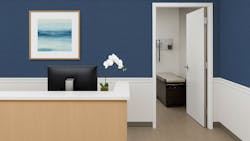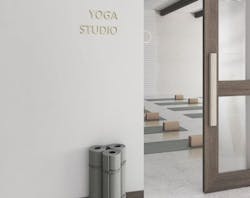Built to Withstand, Designed to Impress: The Wallcoverings Doing It All
Key Highlights
- The integration of performance and aesthetic qualities makes modern wallcoverings essential for creating safe, sustainable, and stylish environments.
- Performance ratings and protective systems ensure longevity and maintain hygiene in high-traffic areas, reducing maintenance needs.
- Innovations such as nanotechnology and high-resolution digital printing allow for customized, hygienic, and visually striking wallcoverings.
In a world increasingly attuned to health and hygiene, design professionals are looking beyond the surface. Wallcoverings, once chosen primarily for their aesthetic appeal, are now expected to contribute to cleaner, safer spaces. Thanks to significant advances in material technology, today’s wallcoverings are rising to the challenge. These new, durable, easy-to-clean surfaces can withstand the rigors of commercial and institutional environments while still making a strong design statement.
The Evolving Definition of Wallcoverings
While “wallpaper” might conjure images of delicate florals in residential spaces, modern wallcoverings have evolved far beyond those traditional rolls. The category now includes a wide range of performance materials: Type II and Type III vinyl wallcoverings, woven polyolefin textiles, high-pressure decorative laminates, digitally printed films, PVC-free options, and antimicrobial-coated panels. Each is engineered to meet the specific demands of settings like healthcare facilities, hospitality venues, education spaces, and high-traffic public buildings.
These advanced materials don’t offer just impact and abrasion resistance. They also promote hygiene by minimizing the potential for microbial growth and simplifying cleaning protocols.
Hygienic by Design
One of the key advantages of performance wallcoverings is their non-porous surface. Vinyl wallcoverings, in particular, do not absorb moisture, making them inhospitable to mold and bacteria. Many are now manufactured with built-in antimicrobial agents, which inhibit the growth of microbes directly on the surface.
This makes them a go-to solution for spaces where cleanliness is paramount. From patient rooms and corridors to commercial kitchens and restrooms, hygienic wallcoverings help reduce the burden on maintenance teams while supporting infection control strategies.
Equally important is how these materials hold up under frequent cleaning. In environments where harsh disinfectants are required, painted drywall can fade, peel, or degrade. By contrast, wallcoverings designed for commercial use are tested for chemical resistance and scrub durability, ensuring they can withstand repeated cleaning cycles without compromising their appearance or integrity.
Technology at Work
What’s fueling the rise of hygienic wallcoverings? A combination of material science and printing innovation. Manufacturers are investing in coatings and substrates that offer both performance and environmental responsibility. Some wallcoverings now incorporate advanced polyurethane topcoats for stain resistance, while others use nanotechnology to create invisible barriers that repel water, oils, and pathogens.
Digitally printed wallcoverings are also making an impact. With high-resolution imaging and customizable substrates, designers can create bespoke solutions that are both hygienic and visually compelling, offering the best of both worlds for branded environments, healing spaces, and hospitality.
Sustainability is another part of the innovation story. The market has seen a sharp rise in PVC-free wallcoverings that meet rigorous environmental certifications while still delivering performance, including products made with recycled content, water-based inks, and non-toxic finishes.
Beyond Clean: Built for Longevity
Durability and hygiene go hand in hand. In high-traffic areas, surface damage can lead to cracks or worn spots that trap dirt and harbor bacteria. Choosing a wallcovering with the appropriate performance rating, such as Type II for heavy-duty traffic or Type III for severe conditions, can help maintain a hygienic surface over time.
Additionally, wall protection systems that integrate design-forward wallcoverings with corner guards, chair rails, and crash rails offer a holistic solution. These systems protect vulnerable areas while maintaining a cohesive aesthetic and minimizing maintenance over the long term.
A Future-Proof Finish
As the commercial interiors industry continues to prioritize wellness, wallcoverings are playing a more strategic role in design. Their ability to deliver durability, hygiene, and visual impact makes them an indispensable tool in today’s specification toolkit.
Designers no longer have to choose between performance and beauty. With today’s wallcoverings, you can have both—plus the confidence that your surfaces are doing more than just looking good. They’re working hard behind the scenes to support cleaner, safer, and more sustainable environments.
About the Author
Heidi Lapka
Heidi Lapka serves as the executive director of the Wallcoverings Association, a non-profit trade association that provides a vehicle for communications between various segments of the wallcoverings industry and design professions.

